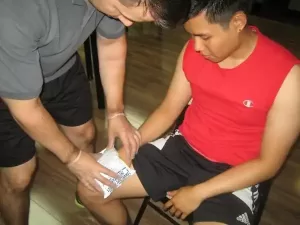
One of the Ontario’s best first WSIB and workplace approved first aid and CPR provider is Mississauga First Aid. This provider is located in the bustling central district, with several other training facilities in the city. Students receive the best possible training with Mississauga First Aid, with only knowledgeable, experienced and friendly instructors and staff. Participants that enrol in standard first aid, the most popular course, will learn how to manage and recognize emergencies that involve heart attacks, stroke, fractures, head injuries, neck injuries, abrasions, amputations, deadly bleeding, hypothermia, poisoning, seizure, diabetic emergencies and many more. Typical participants include doctors, teachers, students, nurses, physiotherapists, CBSA employees, government employees, police officers, security guards, life guards and fire fighters to name a few. Registration for first aid training in Mississauga can be completed on this page or using the information available below.
Introduction to the training program
Basic first aid, CPR and AED
The most popular basic first aid course is standard first aid and it is approximately 18 hours long. CPR and AED training is also include. AEDs or automated external defibrillators are machines that are hooked to the chest and supply the heart with electrical shock during cardiopulmonary resuscitation. Other basic first aid topics include:
-
Icing an injured wrist to help with inflammation and pain Emergency response system
- Choking emergencies
- Basic wound care
- Bleeding emergencies
- Fall victims
Stand-alone CPR classes have three categories: A, C, and HCP. First two are for first time trainees and the last is for health care providers. All levels include training for CPR on adult victims while only C and HCP include CPR training for child and infant victims. All these topics include knowledge and skill building, used during an examination and evaluation near the completion of a program. To pass, a student needs to have:
- Complete attendance
- At least 75 percent on the written exam
- Good demonstration of first aid and CPR skills
Certificates
All students receive WSIB approved cards once a program is completed. Wall-mount sized certificates are available if you request them. All certificates expire after 36 months but Mississauga First Aid offers recertification classes for participants with current standard first aid awards. Standard First aid recertification is 8 hours long, available to participants that meet several prerequisites.
Private classes
Students can book private instructors for special training at home or for events like conferences and seminars. Big groups of trainees usually request private classes as well, or even students with scheduling problems. Be sure to inquire about schedules and rates before you book a trainer.
Enrolment and fees

Mississauga First Aid offers quick and easy enrolment through four different ways: e-mail, telephone call, in person, or website. The Mississauga First Aid website has a list of classes, rates, schedules, and private instructors. E-mails and the registration form on the website can be filled out whenever it is convenient, but expect replies during business hours. If you plan on enrolling in person or calling, please conduct them during business hours as well.
All fees are paid in full during enrolment so students don’t worry about expenses and get distracted during training. Total fees are inclusive of tuition, taxes, certificates, and St Mark James training manuals. If you decide to drop out of a program, a full refund will be given to you, as long as a 72 hour notice was given to the staff.
Did You Know?
Osteoarthritis
Arthritis is a condition where the joint becomes inflamed, causing pain and immobility. It usually appears with age, getting worse as a person becomes older. This happens when the fluid that keeps the bone from rubbing against the tissue or sac begins to decrease in volume. The continuous rubbing of the bone against tissue causes it to become irritated and damaged. This is called osteoarthritis.
